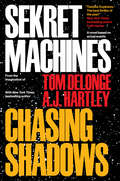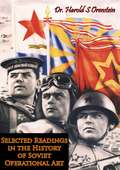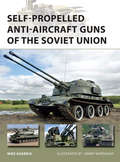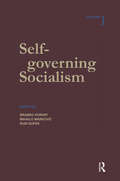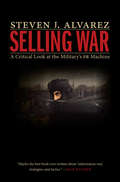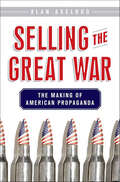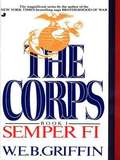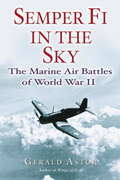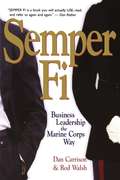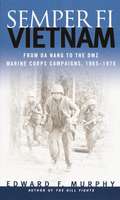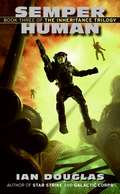- Table View
- List View
Sekret Machines Book 1: Chasing Shadows
by Tom Delonge Aj HartleyFor those who know... that something is going on... The witnesses are legion, scattered across the world and dotted through history, people who looked up and saw something impossible lighting up the night sky. What those objects were, where they came from, and who--or what--might be inside them is the subject of fierce debate and equally fierce mockery, so that most who glimpsed them came to wish they hadn't. Most, but not everyone. Among those who know what they've seen, and--like the toll of a bell that can't be unrung--are forever changed by it, are a pilot, an heiress, a journalist, and a prisoner of war. From the waning days of the 20th century's final great war to the fraught fields of Afghanistan to the otherworldly secrets hidden amid Nevada's dusty neverlands--the truth that is out there will propel each of them into a labyrinth of otherworldly technology and the competing aims of those who might seek to prevent--or harness--these beings of unfathomable power. Because, as it turns out, we are not the only ones who can invent and build...and destroy. Featuring actual events and other truths drawn from sources within the military and intelligence community, Tom DeLonge and A.J. Hartley offer a tale at once terrifying, fantastical, and perhaps all too real. Though it is, of course, a work of... fiction?
Select Letters of Christopher Columbus: With Other Original Documents, Relating to His Four Voyages
by Christopher ColumbusFive letters by Columbus describing his first, third, and fourth voyages; another by Dr Chanca, physician, descriptive of the second voyage; and an extract from the will of Diego Mendez, one of Columbus's officers on the fourth voyage.-Print ed.
Selected Letters of Martha Gellhorn
by Caroline Moorehead Martha GellhornThe first collected letters of this defining figure of the twentieth-century Martha Gellhorn's heroic career as a reporter brought her to the front lines of virtually every significant international conflict between the Spanish Civil War and the end of the Cold War.
Selected Readings in the History of Soviet Operational Art
by Harold S. OrensteinRenowned and respected military expert Dr. Harold S Orenstein is well known for his translations and analyses of Soviet military history and doctrine. In this volume he has collected a number of historical papers discussing topics such as Soviet tactics, deep battle, deep operation, successive operations and operational art. These papers were written by leading Soviet military leaders and theoreticians and shine a fascinating light on the tactics and strategy of the Red Army.
Selections from Herodotus
by Amy L. Barbour Megan O. DrinkwaterThe writings of Herodotus, historian, observer, and delightful storyteller, have long been favorites among teachers and students of the Greek language. The selections in this book will provide reading in the second year for the student who has begun his or her Greek with Homer and who presumably has had no acquaintance with Attic Greek. The book is equally well fitted for the use of the student who has begun in the orthodox fashion with Attic Greek and followed it by Homer. <p><p>This second Oklahoma edition is enhanced by Megan O. Drinkwater's addition of chapter and section references to the complete works of Herodotus.
Selective Security: War and the United Nations Security Council since 1945 (Adelphi series #395)
by Adam Roberts Dominik ZaumIn contrast to the common perception that the United Nations is, or should become, a system of collective security, this paper advances the proposition that the UN Security Council embodies a necessarily selective approach. Analysis of its record since 1945 suggests that the Council cannot address all security threats effectively. The reasons for this include not only the veto power of the five permanent members, but also the selectivity of all UN member states: their unwillingness to provide forces for peacekeeping or other purposes except on a case-by-case basis, and their reluctance to involve the Council in certain conflicts to which they are parties, or which they perceive as distant, complex and resistant to outside involvement. The Council’s selectivity is generally seen as a problem, even a threat to its legitimacy. Yet selectivity, which is rooted in prudence and in the UN Charter itself, has some virtues. Acknowledging the necessary limitations within which the Security Council operates, this paper evaluates the Council’s achievements in tackling the problem of war since 1945. In doing so, it sheds light on the division of labour among the Council, regional security bodies and states, and offers a pioneering contribution to public and governmental understanding of the UN’s past, present and future roles.
Self-Inflicted Wound: Allied Defeat In Crete, May 1941
by Major Andrew J. KosticThe Germans appeared unstoppable during the early stages of World War II. Inexperienced Allied forces were willing to fight, but the sentiment was the Germans were too powerful. Defeat became a forgone conclusion. To defend at all costs no longer appeared viable. Withdrawal and evacuation seemed almost commonplace in Allied strategy.Great Britain and Germany identified early in the war the strategic importance of the island of Crete for conducting military operations in the Mediterranean. Operationally the British maintained naval supremacy in the Mediterranean, while the German Luftwaffe ruled the skies.The German plan for the occupation of Crete, Operation MERCURY, called for gliders and Hitler's elite paratroops to conduct the largest airborne operation to date. The plan pitted 22,000 men and 1280 aircraft against an erroneously estimated enemy strength of 5,000 men. The success of this plan relied upon surprise and the paratroops securing one of the three airfields on the island so reinforcements could be flown in.A reluctant Crete Force Commander set the tone for subordinate commanders' leadership failures. The invasion began the morning of 20 May 1941. The Germans suffered heavy casualties. At the end of the first day of fighting, they were short ammunition, and the Allies maintained control of the airfields. However, the battalion commander defending the airfield at Maleme, lacking communications and situational awareness, was unaware of the success of his unit and that night mistakenly ordered its withdrawal from the airfield. The Germans occupied the airfield in the morning and reinforcements were flown in. The Allies conducted an attack the night of 21 May to retake the airfield, but poor Allied leadership at the Brigade and Division level resulted in failure. Consequently, the Germans were able to mass combat power on the island and defeat the Allies.
Self-Propelled Anti-Aircraft Guns of the Soviet Union
by Mike GuardiaDuring the Cold War, the Soviet Army was perhaps the deadliest fighting force the world had ever seen. Within its mechanized forces, the Soviets accomplished something that their American counterparts never could - the fielding of a self-propelled anti-aircraft gun (SPAAG) that could keep pace with its heavy armored formations. This book examines the design, development and operational history of the Soviet Union's Cold War SPAAGs: the ZSU-37, ZSU-57-2, the infamous ZSU-23-4, and the 9K22 Tunguska (better known by its NATO reporting name: SA-19 "Grison"). These vehicles excelled in their air defense role, and many US Department of Defense publications were dedicated to examining how to defeat the ZSU and its radar tracking system. These formidable weapons were encountered again in Iraq during Operation Enduring Freedom, and had equipped Russian forces in afghanistan in the intervening period, cementing their place in the landscape of modern warfare. This study explores the full history of the SPAAGs with revealing photographs, technical illustrations and detailed analysis.
Self-governing Socialism: A Reader
by Branko HorvatFirst published in 1975. VOLUME ONE covers Historical Development Social and Political Philosophy. No study or collection of material approaching self-government as a worldwide phenomenon and dealing with all The purpose of the present Reader is to fill this gap. This Reader traces the development self-government as a worldwide phenomenon and dealing with all This Reader traces the development of self-government from its beginnings as an apparently utopian idea of a handful of visionaries a century and a half ago to its implementation on a national scale in the contemporary world. All fundamental aspects of this development are dealt with—historical, philosophical, sociological, political, and economic. Contributions from some twenty countries are included. Several synthetic papers have been written especially for this book; because of their inclusion, as well as the comprehensiveness of the book’s coverage, this work transcends the usual confines of a reader.The edtiors’ goal was to assemble all important contributions of historical and theoretical value in one book.
Selling Intervention and War: The Presidency, the Media, and the American Public
by Jon WesternSelling Intervention and War examines the competition among foreign policy elites in the executive branch and Congress in winning the hearts and minds of the American public for military intervention. The book studies how the president and his supporters organize campaigns for public support for military action. According to Jon Western, the outcome depends upon information and propaganda advantages, media support or opposition, the degree of cohesion within the executive branch, and the duration of the crisis. Also important is whether the American public believes that military threat is credible and victory plausible. Not all such campaigns to win public support are successful; in some instances, foreign policy elites and the president and his advisors have to back off.Western uses several modern conflicts, including the current one in Iraq, as case studies to illustrate the methods involved in selling intervention and war to the American public: the decision not to intervene in French Indochina in 1954, the choice to go into Lebanon in 1958, and the more recent military actions in Grenada, Somalia, Bosnia, and Iraq. Selling Intervention and War is essential reading for scholars and students of U.S. foreign policy, international security, the military and foreign policy, and international conflict.
Selling War: A Critical Look at the Military's PR Machine
by Steven J. AlvarezIn the spring of 2004, army reservist and public affairs officer Steven J. Alvarez waited to be called up as the U.S. military stormed Baghdad and deposed Saddam Hussein. But soon after President Bush’s famous PR stunt in which an aircraft carrier displayed the banner “Mission Accomplished,” the dynamics of the war shifted. Selling War recounts how the U.S. military lost the information war in Iraq by engaging the wrong audiences—that is, the Western media—by ignoring Iraqi citizens and the wider Arab population, and by paying mere lip service to the directive to “Put an Iraqi face on everything.” In the absence of effective communication from the U.S. military, the information void was swiftly filled by Al Qaeda and, eventually, ISIS. As a result, efforts to create and maintain a successful, stable country were complicated and eventually frustrated. Alvarez couples his experiences as a public affairs officer in Iraq with extensive research on communication and government relations to expose why communications failed and led to the breakdown on the ground. A revealing glimpse into the inner workings of the military’s PR machine, where personnel become stewards of presidential legacies and keepers of flawed policies, Selling War provides a critical review of the outdated communication strategies executed in Iraq. Alvarez’s candid account demonstrates how a fundamental lack of understanding about how to wage an information war has led to the conditions we face now: the rise of ISIS and the return of U.S. forces to Iraq.
Selling a ‘Just’ War
by Michael J. ButlerButler sheds light on how American political leaders sell the decision to intervene with military force to the public and how a just war frame is employed in US foreign policy. He provides three post-Cold War examples of foreign policy crises: the Persian Gulf War (1990-91), Kosovo (1999), and Afghanistan (2001).
Selling the Great War: The Making of American Propaganda
by Alan AxelrodThe riveting, untold story of George Creel and the Committee on Public Information -- the first and only propaganda initiative sanctioned by the U.S. government.When the people of the United States were reluctant to enter World War I, maverick journalist George Creel created a committee at President Woodrow Wilson's request to sway the tide of public opinion. The Committee on Public Information monopolized every medium and avenue of communication with the goal of creating a nation of enthusiastic warriors for democracy. Forging a path that would later be studied and retread by such characters as Adolf Hitler, the Committee revolutionized the techniques of governmental persuasion, changing the course of history. Selling the War is the story of George Creel and the epoch-making agency he built and led. It will tell how he came to build the and how he ran it, using the emerging industries of mass advertising and public relations to convince isolationist Americans to go to war. It was a force whose effects were felt throughout the twentieth century and continue to be felt, perhaps even more strongly, today. In this compelling and original account, Alan Axelrod offers a fascinating portrait of America on the cusp of becoming a world power and how its first and most extensive propaganda machine attained unprecedented results.
Semialignment and Western Security (Routledge Library Editions: Cold War Security Studies #45)
by Nils ØrvikThis book, first published in 1986, is a major study of semialignment and a review of the individual nations within NATO to which the model could be applied. Towards the end of the Cold War, there arose within NATO this intermediate category between alignment and nonalignment, whereby a member state enjoyed the status and facilities of NATO membership while disassociating itself from certain NATO programmes. This book analyses the phenomenon, and the possibility that it weakened the credibility of NATO deterrence and the defence posture versus the Soviet Union.
Semillas amargas (Tríptico de Asclepia #Volumen 1)
by Ian TregillisLa primera entrega del Tríptico de Asclepia, una historia bélica sobrenatural y alternativa de dimensiones épicas En los albores de la Segunda Guerra Mundial las fuerzas nazis cuentan con superhombres y las británicas con demonios de la naturaleza. Pronto, un hombre normal y corriente se verá atrapado entre los dos bandos. Febrero de 1939. Barcelona. Raybould Marsh, agente del Servicio Secreto de Inteligencia británica, trata de reunir información sobre el febril rearme alemán en territorio español, cuando se topa con una mujer de cuya cabeza salen unos extraños cables. Ella le mira como si le conociera y, en un instante, desaparece de su vista. Él nunca podrá olvidar su rostro. Agosto de 1939. Londres. Una inquietante película revela al MI6 británico la existencia de personas con habilidades «especiales» que operan bajo las órdenes del peligroso doctor Von Westarp. Sus poderes son tan increíbles como mortíferos y alguien debe hacerles frente cuanto antes. A partir de ese momento Raybould Marsh se convierte en el responsable de impedir, como sea, la inminente invasión nazi. En un intento desesperado se reunirá con los brujos que apoyan, en la sombra, a las fuerzas británicas. Sin embargo, el precio que habrá de pagar para vencer al enemigo será muy superior al que había imaginado... La crítica ha dicho... «Un escritor de gran talento.» George R. R. Martin, autor de Juego de tronos «Excitante e intensa... El choque entre magia y ciencia (perversa) encaja perfectamente con el tumultuoso escenario bélico.» Publishers Weekly
Semper Fi
by W.E.B. GriffinFrom Shanghai to Wake Island, the Corps was America's first line of defense as the winds of war exploded into the devastating surprise attack on Pearl Harbor. This is the story of the men of the Marine Corps, their loves and loyalties, an elite fraternity united by courage and honor, as they steel themselves for battle, prepared to make the ultimate sacrifice. . . "Action-packed. . . Difficult to put down. " -- THE MARINE GAZETTE
Semper Fi
by W.E.B. GriffinFrom Shanghai to WAke Island, the Corps was America's first line of defense as the winds of war exploded into the devastating surprise attack on Pearl Harbor. Now, the bestselling author of the acclaimed BROTHERHOOD OF WAR saga brings to life the men of the Marine Corps--their loves and their loyalties--as they steeled themselves for battle, and prepared to make the ultimate sacrifice...
Semper Fi Cowboy (Lone Star Leathernecks #1)
by Heather LongA Leatherneck by any other name can still kick ass, which is just what retired United States Marine Corps Captain Tanner Wilks plans to do when he returns to his Texas family ranch to care for his ailing father. And nothing will stop him from achieving his mission—not even a lithe, brown-eyed town veterinarian who seems hell-bent on driving him wild.Captain Tanner Wilks, honorably discharged from the U.S. Marine Corps, returns home to find his father struggling after his latest heart attack. Worse yet, Julia Heller—the sexy new girl in town that he once spent a hot night with—is the resident veterinarian who&’s made a home for herself at Round Top ranch, and doesn&’t seem to be in a rush to repeat their time together. It falls on Tanner&’s shoulders to take on the ranch and keep an eye on his father before he falls victim to another heart attack. But Julia doesn&’t appreciate Tanner coming in or pursuing her. Even if he&’s hot as hell and can make her quiver with just a look. Ousting her may give Tanner the leverage he needs to corral his father, but first he has to wrestle with his own heart.
Semper Fi in the Sky
by Gerald AstorHere, one of America’s most popular military historians re-creates, using their own moving and powerful voices, the true stories of the U. S. Marine pilots who flew the Allies to victory in World War II. These riveting accounts recreate conflicts ranging from the Marines’ gallant defense of Wake Island, where Captain Henry “Baron” Elrod destroyed two enemy planes before joining the fight on the ground, earning a posthumous Medal of Honor in the last-ditch attempt to stave off the Japanese, to the Battle of Midway and Guadalcanal. Running the gamut from Second Lieutenant Alvin Jensen’s single-handed destruction of twenty-four grounded Japanese aircraft on Kahili to Lieutenant John W. Leaper’s sawing off a Kamikaze’s tail with his propeller over Okinawa, these thrilling oral histories of the Pacific war’s air battles bring them to life in all their terror and triumph. From the Trade Paperback edition.
Semper Fi: Business Leadership the Marine Corps Way
by Dan Carrison Rod WalshFor more than 200 years, the U. S. Marine Corps has been a paragon of world-class leadership, excelling in the areas of motivation, training, and management. Semper Fi - which since its hardcover publication has become a best-selling, business leadership classic - shows readers how to adapt these proven practices for their own organizations. Now in a paperback edition with a new introductionby the authors, Semper Fi goes behind the scenes to pinpoint what works for the USMC, showing readers how to create a training and management culture that brings out the best in all their employees. The book gives readers tough, practical tips for: * inspiring individual initiative * rewarding hard work * encouraging loyalty * working with limited resources * dealing with change * leading the troops at every level of the organization This is not, according to Dan Rather, one of those mumbo-jumbo, pseudo-philosophical books on leadership. Semper Fi is a book you will actually USE, read, and refer to again and again.
Semper Fi: Vietnam
by Edward F. MurphyFrom their early days in 1965 when the order of the day was to drive the insurgent Viet Cong from the villages around Da Nang to the final, dramatic evacuation of Saigon ten years later, Semper Fi Vietnam relates the whole gutsy, glorious saga of the Marines in Vietnam in stark, riveting detail. Acclimating to their strange new surroundings occupied the Marines' first few weeks in South Vietnam. Throughout the day, peasants dressed in pajama-like clothing and sporting conical hats worked the paddies behind the heaving water buffalo. If daytime scenes appeared bucolic, the arrival of sunset quickly changed that perception. Gunfire and explosions erupted at dusk. Marines nervously watched bright tracers cut colorful swaths across the night sky. From distant bamboo thickets, mortar shells flew skyward to crash in the paddies. The Marines were learning that the war in South Vietnam was unlike anything for which they'd been trained.
Semper Human
by Ian DouglasThe final conflictChaos has erupted throughout the known galaxy, threatening countless colonies and orbital habitats--as the Associative struggles vainly to keep the peace. Extreme measures are called for in these times of dire crisis, and the Star Marines are awakened from their voluntary 850-year cybe-hibe sleep. But General Trevor Garroway and his warriors are about to discover that the old rules of engagement have drastically changed . . .The end begins with an old-style assault on rebels at the Tarantula Stargate. But true terror looms at the edges of known reality. Humankind's eternal enemy--the brutal, unstoppable Xul--approaches, wielding a weapon monstrous beyond imagining. Suddenly not only is the future in jeopardy, but the past is as well--and if the Marines fail to eliminate their relentless xenophobic foe once and for all, the Great Annihilator will obliterate every last trace of human existence.
Semper Mars
by Ian DouglasThe Year is 2040.The Marines have landed on Mars to guard the unearthed secrets of an ancient and dangerous alien race: Ourselves.Scientists have discovered something astonishing in the subterranean ruins of a sprawling Martian city: startling evidence of an alternative history that threatens to split humanity into opposing factions and plunge the Earth into chaos and war. The USMC -- a branch of a military considered, until just recently, to be obsolete -- has dispatched the Marine Mars Expeditionary Force, a thirty-man weapons platoon, to the Red Planet to protect American civilians and interest with lethal force if necessary.Because great powers are willing to devastate a world in order to keep an ancient secret buried. Because something that was hidden in the Martian dust for half a million years has just been unearthed . . . something that calls into question every belief that forms the delicate foundation of civilization . . .Something inexplicably human.
Semper Parents: Supporting Your Marine and Sharing the Journey
by Mary Regner“Semper Parents is the best guide I have ever seen for any family member or friend who seeks a deeper understanding of Marine Corps life in order to provide greater support … for their Marine.”—Michael McNamara, president, All Marine Radio“… this book should be read by every American servicemember, their parents, and their grandparents! … the lessons on relationships, deployments, transfers, and even tragedy have broad application across all services …”—General James Conway, (Ret), 34th Commandant, US Marine CorpsMany parents have mixed feelings when their child decides to become a United States Marine. In Semper Parents, Mary Regner shares practical tips and perspective from several Marines, spouses, and parents with a variety of USMC experiences to help new Marine parents find purpose in the Marine Corps, understand more about military life, cope with concern and worry, celebrate traditions, and nurture changing relationships.“The guide all Marine parents need … shows how parents can join their Marine on this incredible and sometimes terrifying journey. … Read it, keep it nearby, and give it as a gift to the military family members you care about most.”—Besa Pinchotti, executive director and CEO, National Military Family Association“… an invaluable guide to help navigate the trials, tribulations, and beautiful victories of those serving and the family members who endure the journey of service with them.”— Robin Carpenter, mother of Medal of Honor recipient Corporal Kyle Carpenter
Send For Me: A Novel
by Lauren FoxINSTANT NEW YORK TIMES BESTSELLER*A Today Show #ReadWithJenna Book Club Pick* *An Indie Next Great Read*'[A] vivid depiction of a family's heartbreak, its rending and rebuilding.' - Clare Lombardo, New York Times Book Review 'Spanning generations and continents, from pre-WWII Germany to current day midwestern America, Send For Me is a richly imagined testament to the ties that bind.' Whitney ScharerGermany 1930s. Annelise is a dreamer: imagining her future while working at her parents' popular bakery in Feldenheim, Germany, anticipating all the delicious possibilities yet to come. There are rumours that anti-Jewish sentiment is on the rise, but Annelise and her parents can't quite believe that it will affect them; they're hardly religious at all. But as Annelise falls in love, marries, and gives birth to her daughter Ruthie, the dangers grow closer: a brick thrown through her window; a childhood friend who cuts ties with her; customers refusing to patronise the bakery. Luckily Annelise and her husband are given the chance to leave for America, but they must go without her parents, whose future and safety are uncertain.Two generations later, in a small Midwestern city, Ruthie's daughter and Annelise's granddaughter, Clare, is a young woman newly in love. But when she stumbles upon her grandmother's letters from Germany, she sees the history of her family's sacrifices in a new light, and suddenly she's faced with an impossible choice: the past, or her future. A novel of dazzling emotional richness that is based on letters from Lauren Fox's own family, Send for Me is an epic and intimate exploration of mothers and daughters, duty and obligation, hope and forgiveness.
